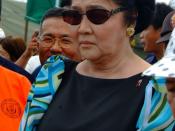In "Desiring Images: Representation and Spectacle in Dogeaters" by Myra Mendible published in March 2002 in Studies in Contemporary Fiction as part of a critique of Dogeaters, a play written by Jessica Hagedorn, centralizes its focus on the concept of the importance of image driven perceptions encompassing the complexities of a society already enthralled in a confused atmosphere of capitalism, social divisions, and the plague visions of postcolonial ramifications. According to Mendible, Hagehorn mentioned that the intensity of the colonizers was so imbedded in the mind that the familiarity of indigenous people had been almost forgotten. The importance of depiction in this play is to illustrate how one culture is replaced by the illusion of another.
Mendible uses the characters (real and imagined), such as Imelda Marcos as a display of ÃÂfeminine vulnerability and subjugation that both mediate and reflect (her husband's) political authority.ÃÂ Imelda Marcos physical appearance is perceived as a wavering symbol of the Filipino government and its cultural identity.
The facets of her weight, appearance, facial expressions, and the fact that she gets to have the chance to exercise her power next to her husband gives the illusion of something whimsical in the psyche of the Filipino ÃÂsensibilityÃÂ (1).
The scheme of the narrative moves forth the dilemma of representation in a surrounding where the lines of cultural and political have crossed. Mendible examines the perplexed identities Hagedorn uses by introducing the different characters in her play which through dialogue reveal the postcolonial problems combined with postmodern illusion of how ÃÂAmericaÃÂ is or can be flushes the reality of the way thing are in the Philippines. The characters in HagedornÃÂs play are in a state of fantasy of how they are actors in Hollywood and elude reality of becoming the desire of someone elseÃÂs...


